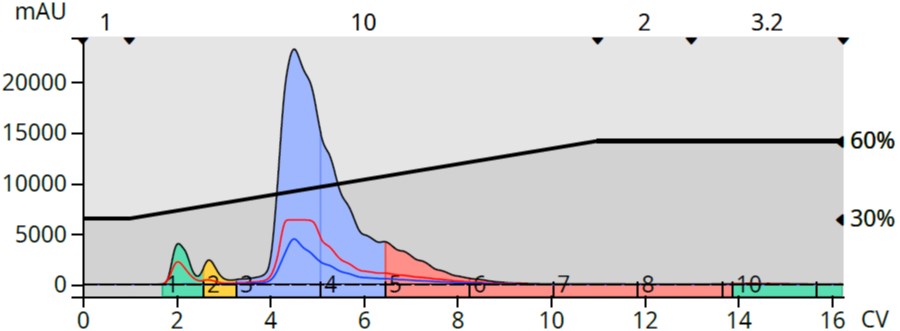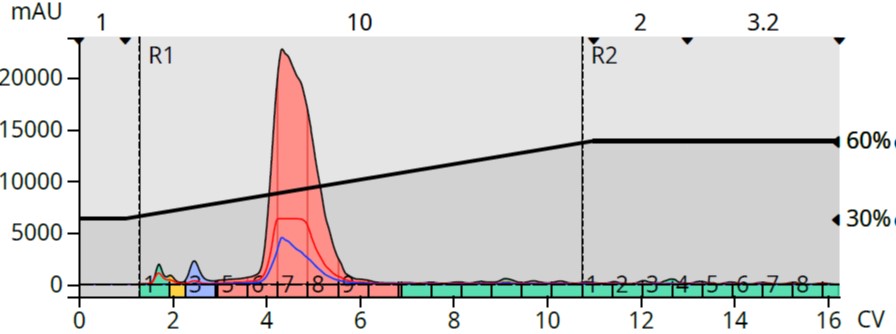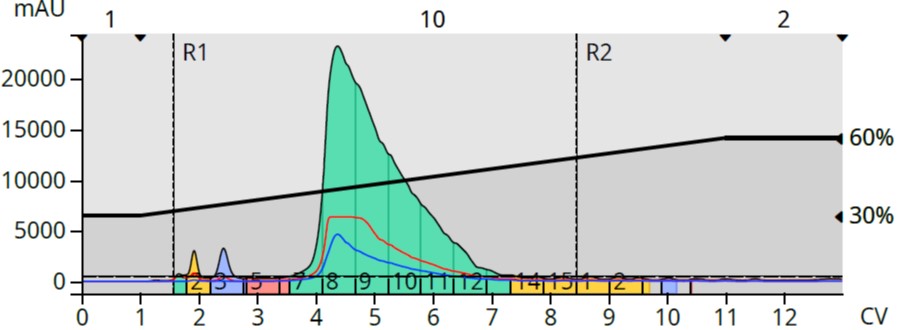Flash chromatography is the most commonly used purification tool for organic and medicinal chemists whose reaction scales typically range from milligrams to grams. The column size to be used for the purification of these reaction mixtures is selected either by using the 1% rule which states that for many reaction mixtures, a crude reaction mixture load equaling 1% of the column’s media weight often will provide the needed purity, assuming the right elution method is selected. While this strategy can work, often chemists either overload or underload the selected column resulting in low product purity which requires re-purification. In both situations, the chemists wastes time, solvent, and the cost of the column.
As an alternative strategy to method development, many chemists now use a TLC to gradient algorithm developed and patented by Biotage that suggests a column size based on the reaction mixture amount, and its TLC Rf values, thus minimizing chances for mismatching the reaction mix load, column size, and gradient.
Either way, if a reaction needs scaling, so will the purification of the crude mixture. So, how is this done and is it scalable? Those are the questions I will address in this post.
While chemical reactions can be challenging to scale, purification scales quite easily. With synthesis, many variables factor into a reaction’s scale-up including reaction solvent, reagent concentration, temperature, vessel size, heating source, time, etc. For purification, assuming the larger reaction mixture has the same or very similar chemical profile in terms of product yield and by-products, scale up is based on column loading percent.
For example, if a 100 mg crude reaction mixture was successfully purified on a 10-gram flash column (1% load), then a 1-gram crude reaction will need a 100-gram column to accomplish the same purification, a 15-gram reaction will need a 1500 gram column, and so on. When using a Biotage flash system (Selekt™ or Isolera™), no changes to the purification gradient are needed when the methods are based on column volumes (CV). Flow rates will also automatically increase reflecting the larger column. All you, as the chemist, needs to do is increase the sample load proportionally (keep the same sample concentration) and, perhaps, use a larger fraction collection vessel for the increased fraction volumes generated by the larger columns.
To further show flash scalability, I performed three syntheses, and their purifications, at different scales – 1mM, 2mM, and 5 mM – reacting isatoic anhydride and benzylamine (2x excess) to create 2-amino-N-benzylbenzamide and CO2. We all know that the majority of chemical reactions generate by-products as well as the intended product and that they need to be removed from the mixture in order to isolate the target product with high purity, these reactions were no different.
For my reactions, I used normal-phase flash chromatography with a 30-60% ethyl acetate in hexane gradient and dry loading. Table 1 shows the approximate amounts of reagents used for each synthesis, the theoretical product yield, and the actual yield.
Table 1. Reaction reagent weights with theoretical and actual synthetic yields.
|
Reagent |
MW |
1mM |
2mM |
5mM |
|
Isatoic anhydride (mg) |
163 |
163 |
326 |
815 |
|
Benzylamine (mg) |
107 |
214 |
428 |
1070 |
|
Product (2-amino-N-benzylbenzamide) |
MW |
Yield |
||
|
Theoretical yield (mg) |
226 |
226 |
452 |
1130 |
|
Actual synthetic yield (mg) |
|
398 |
664 |
1710 |
After entering the TLC data for these reactions, my Biotage® Selekt system estimated a load of 449 mg for a 10-gram, high capacity Biotage® Sfär column, or a load of ~4.5% (0.449g/10g). Since my 1mM scale reaction generated a crude yield of 398 mg, I chose to use the prescribed 10-gram column. The purification result showed the product separated from several non-polar by-products, Figure 1.

Figure 1. Normal-phase flash purification of the 1 mM scale reaction mix with a 10-gram column (~4% load), provided removal of lipophilic by-products.
Since the 2mM reaction generated 664 mg of crude dry solids, the 10-gram column was deemed too small so I used a 25-gram column packed with the same silica. Compared to the 4% load from the 1mM scale reaction, the 664 mg crude mix load provided a lower 2.6% load (664 mg/25 g column) and generated a slightly better-looking chromatogram, Figure 2.

Figure 2. 2 mM reaction scale normal-phase purification with a 25-gram column and 2.6% load.
The highest scale reaction, 5mM, created 1.71 grams of solids. Maintaining the same ~4% load capacity used with the 1 mM reaction, a 50-gram column was required (actual load 3.4%). This load generated a similar chromatogram compared to the 1mM purification with a tailing product peak and excellent separation from the lipophilic by-prodcuts, Figure 3.

Figure 3. 5 mM reaction purification with a 50-gram silica column (3.4% load) provided similar results to the other reaction mixture purifications.
The fact that the 1mM and 5mM product peaks tail is not an issue but does indicate loads at, or near, the column’s capacity for these reactions. In fact, the isolated product peaks were analyzed for purity and found to be at least 95% pure by flash-MS. Yields from normal-phase flash chromatography ranged from 49% to 58% of the crude, based on reaction scale, Table 2.
Table 2. Normal-phase purified product yields

These results show that flash chromatography is scalable when loading percentages are similar or maintained. In fact, many CMO and CDMO facilities use large scale flash chromatography to purify APIs that cannot be efficiently crystallized or purifiied by other techniques.
Direct scalability is not just applicable to normal-phase chromatography, reversed-phase purifications are also directly scalable. For more information, click below to read more.

